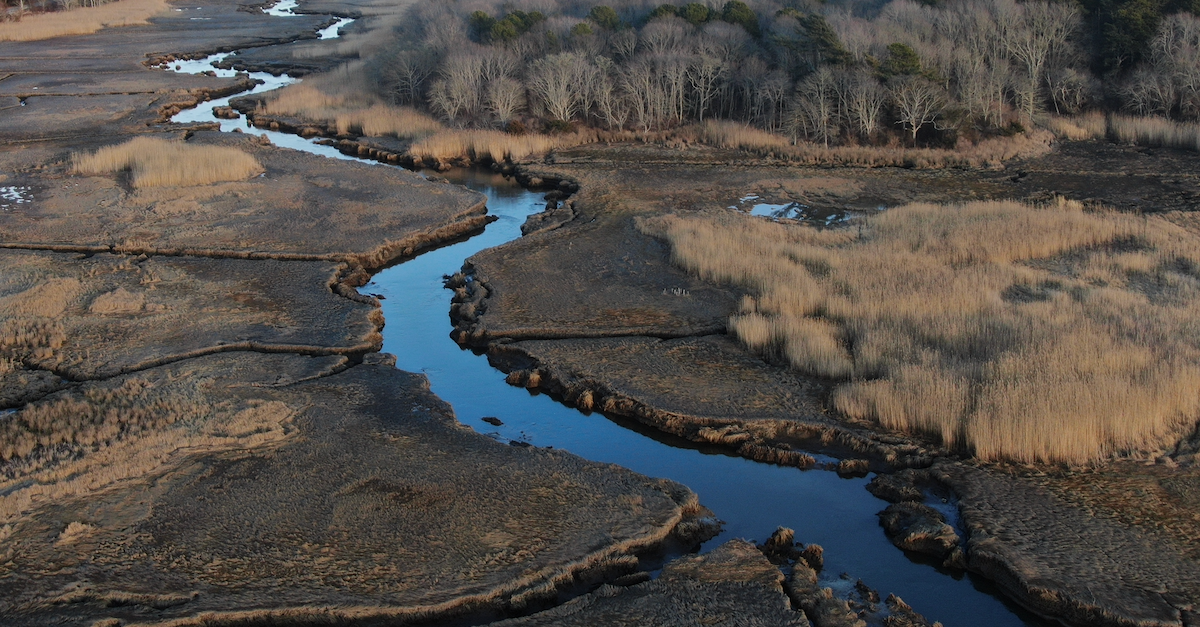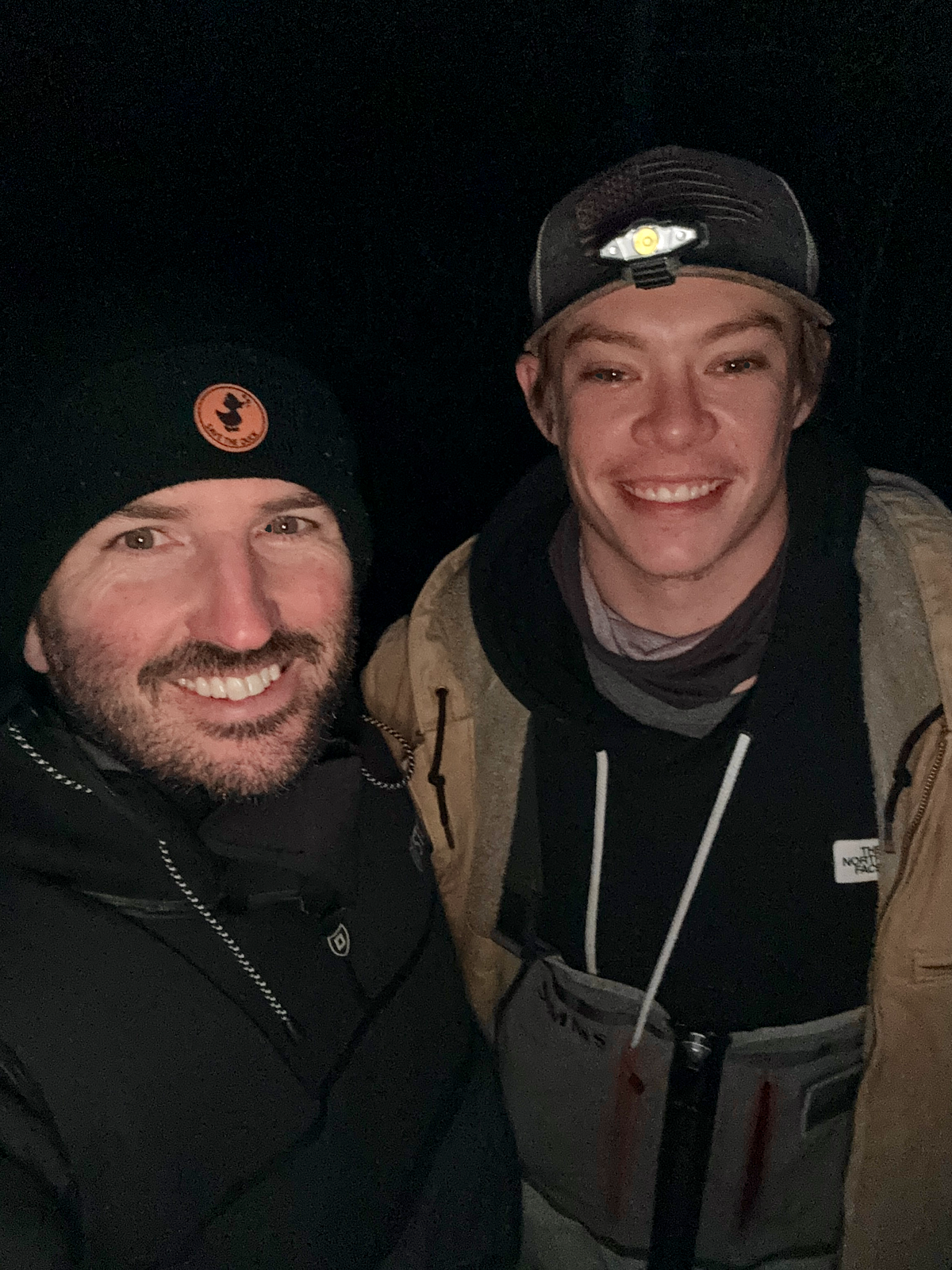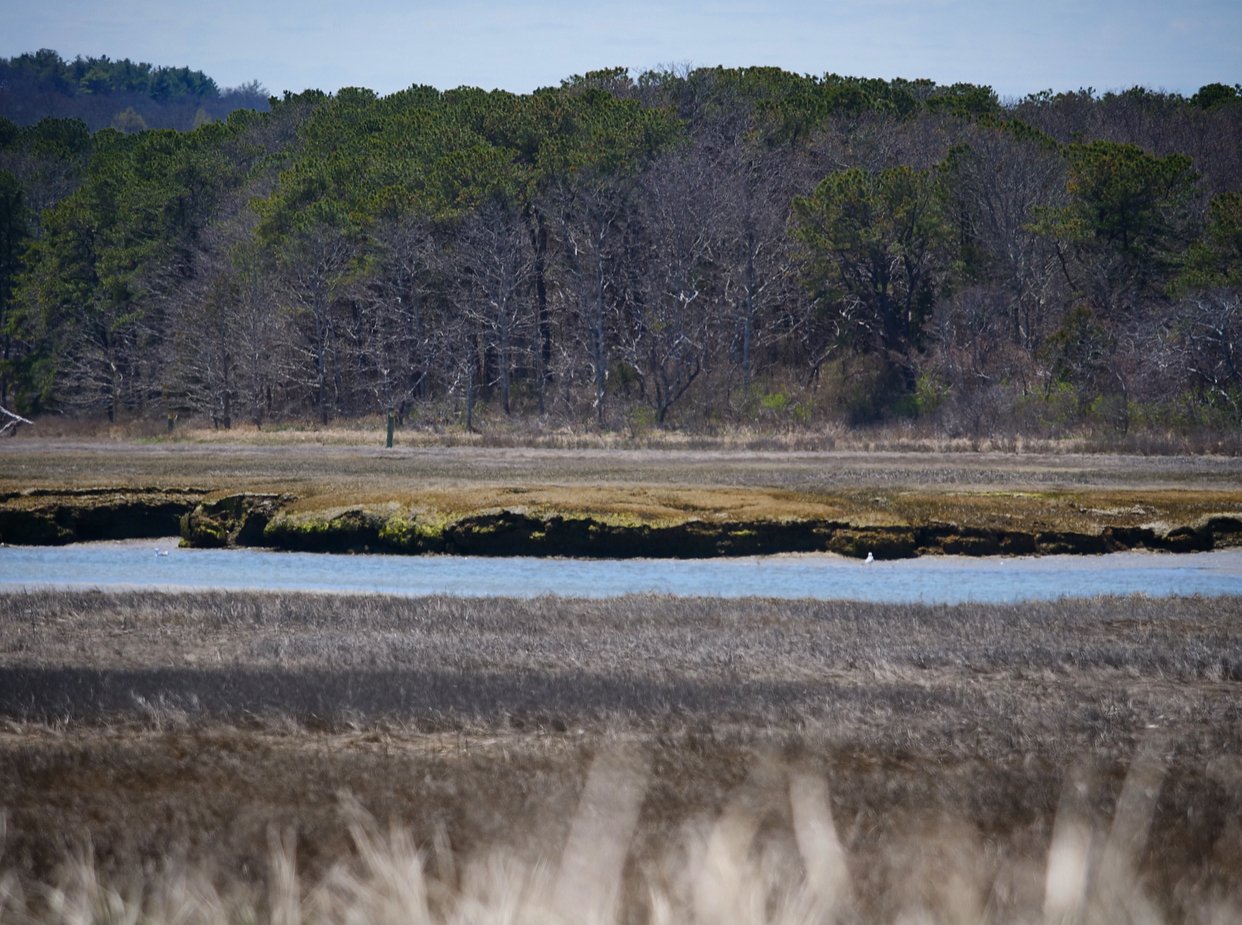For an angler on Cape Cod in early April, there's an exciting in-between season that few experience. The freshwater trout season is well underway, but the main migration of striped bass hasn't yet reached our shores.
It's during this liminal time that the "angler's itch" – that familiar yearning that drives us back to the water – led me last night into the darkness on a mission to find Cape Cod's resident "holdover" striped bass.
The Call of Resident Stripers
There's something special about the striped bass that choose to remain on Cape Cod year-round. While most of their brethren migrate south during the cold months, these brave souls – these true "Cape Codders," if you will – find refuge in our estuaries and backwaters.

The serpentine channels and hidden coves of Cape Cod's backwater estuaries—stunning from above, but deceptively treacherous up close. These pristine waters harbor our resident striped bass, but demand extreme respect from anglers. Deep mud that can trap the unwary, sudden drop-offs in drainage channels, and uneven terrain make night fishing on foot particularly hazardous here. Many spots become completely inaccessible as tides shift. Always scout during daylight hours, bring proper lighting, fish with a buddy when possible, and consider watercraft like kayaks for safer access. The holdover stripers are worth pursuing, but never at the cost of your safety.
Why do they stay when others leave? I imagine the feeding opportunities and the conservation of energy outweigh the benefits of migration. These holdover stripers find sanctuary in places that provide food sources throughout the entire year, even during the harshest winter months.
Last night, my kayak loaded and my dry suit secured (an absolutely essential piece of gear when paddling in dangerously cold spring waters), I set out in search of these year-round residents. With warming April temperatures, these fish would be shaking off their winter lethargy, ready to chase bait and begin behaving more like the active predators we encounter during warmer months.
Good Deeds and Good Company
Sometimes fishing trips begin with the unexpected. As I pulled into the parking lot, I encountered a gentleman with his car hood up – battery dead after a successful clamming expedition. Jumper cables at the ready (a worthwhile addition to any angler's vehicle), I helped him get back on the road.
Perhaps the fish gods would smile upon this good deed!
As I rigged my kayak, a familiar face appeared – Grant Stark, a passionate My Fishing Cape Cod member who relocated from Arizona and fully embraced the Cape's fishing opportunities.

A pre-adventure selfie with MFCC member Grant Stark, who traded Arizona deserts for Cape Cod waters and found not just fish, but a community. Yes My Fishing Cape Cod membership provides intel and information, but the real catch is the friendships formed along the way. Moments later we'd part ways—Grant to his shore spot and me to my kayak—both chasing the same resident stripers on this perfect April night.
He spoke glowingly about the friendships formed through the My Fishing Cape Cod community, connections that had even led to wedding invitations. Grant would be shore fishing tonight while I explored by kayak.
Into the Darkness: Cape Cod's Nocturnal Symphony
As I paddled deeper into the estuary system, darkness enveloped the landscape. The experience of being in nature at night is something few people regularly experience, yet it's extraordinarily invigorating. When your sense of sight is compromised, your hearing compensates – the subtle crack of twigs, the whisper of wind, and the chirps of night creatures become your primary sensory inputs.

While last night's adventure unfolded under a half moon, this full moon captures the ethereal quality of night fishing on Cape Cod. I hope this image helps transport you to those magical moments when the world goes quiet, the water turns to glass, and the celestial light becomes your silent fishing partner. The moon transforms familiar landscapes into mysterious new worlds—where swirls beneath the surface might be stripers tracking your lure through the darkness. There's something primeval about pursuing fish by moonlight that connects us to generations of anglers before us, who never had the convenience of a headlamp.
A pack of coyotes began howling in the distance, their primal chorus echoing across the water. While some find this startling or concerning, I find it thrilling – a reminder of the wild heart still beating within our increasingly developed peninsula. An osprey chirped high above, unusual to hear at night, adding another layer to the natural symphony.
The moon cast enough light that my headlamp remained mostly unnecessary. No wind disturbed the stillness, and only the gentle current hinted at movement. Stars punctuated the clear sky above, completing the perfect backdrop for this nocturnal mission.
The Rich History of Cape Cod's Estuaries
The very waters I navigated that night represent ecological treasures millennia in the making. Cape Cod's estuaries – where freshwater meets saltwater – emerged through the dynamic interplay of geological forces. Glacial retreat sculpted our landscape thousands of years ago, depositing the sand and sediment that would become the Cape's foundation.

Cape Cod is home to many different estuaries. Pictured here is the Town Neck estuary in Sandwich—a dynamic ecosystem facing transformation before our eyes. This vital waterway, once protected by extensive dune systems, has become increasingly vulnerable to storms and sea level rise. Coastal erosion threatens not just the homes along its edges, but also the barrier beach that's allowed the estuary to thrive over centuries. Officials have undertaken an ambitious sand replenishment program, piping in thousands of cubic yards of material to rebuild protective barriers and preserve this fragile environment. As anglers, we're witnessing a race against time to save not just a beautiful fishing spot, but an irreplaceable ecological treasure that's shaped Cape Cod's identity for centuries.
Over time, rising sea levels transformed ancient river valleys into the complex network of bays, inlets, and marshes that define our coastline today. These constantly evolving systems continue to shift and change with each passing storm and tide.
For the Wampanoag people, who inhabited these lands for thousands of years before European settlement, these estuaries were life-sustaining resources. They harvested shellfish and of course caught fish including the striped bass I now pursued. They called striped bass "missuckeke-kequock," and recognized their tendency to return to the same rivers and estuaries year after year, where they were likely taken by use of ancient fish weirs.

In the spring of each year, members of the Massachusett and Wampanoag Native American tribes work with students, educators and artists to construct a fish-weir in honor of the people who built fishweirs 3500 to 5200 years BP (Before Present) in the area that is now urban Boston. Today this fishweir re-creation is located on dry land near what was once an early shoreline that existed when ocean levels were lower and before new land was made by fill of the Back Bay tidal estuary that began in the Colonial period. Photo by PhotoBoston.
When European settlers arrived in the early 1600s, these same estuaries provided crucial harbors, food sources, and eventually supported thriving maritime industries. Today, they serve as ecological nurseries for countless species, natural buffers against coastal storms, and playgrounds for anglers like me.
What makes these estuaries particularly valuable to holdover stripers is their temperature fluctuation. On this April night, the water temperature was easily 10-15 degrees warmer than the adjacent ocean – creating a comfortable haven for fish transitioning from winter's dormancy to spring's activity.
The Hunt Begins: Searching for Signs
My headlamp revealed the first encouraging sign – a flash of silver as a good-sized striper, likely 30 inches, darted through the beam. Then another. And another! [...click here to continue reading →]



Thanks for that journey Ryan … I was sipping on coffee, and floating along with you. Really appreciate all the history and detail too. I look forward to more report/stories. Sorry I never got a chance to say hi at the kickoff … Great event though. That was my first.
I’m glad you enjoyed this adventure John. Many more to come god willing!
The Kickoff was a busy day and I didn’t get a chance to chat much with anyone! LOL.
Hey Ryan. Long time. Can you please remind of the canal bike shop that will ship racks? Thanks 🐟
Hello Art! Yes it has been a while and I hope all is well. I’m not sure if this is the shop you are thinking of, but Canal Cruisers is located on Main St. in Buzzard’s Bay and might have what you’re looking for. Here’s a link to their Facebook page.
Excellent and informative read! I’ve seen the glass eels…amazing.
I’m glad you enjoyed the report Kevin. I hope all is well!
Congratulations Ryan on a successful spring outing! And thank you for mentioning the illegal poaching of young American eels. They are a vital species to the health of our Cape Cod waters and beyond.
They are absolutely vital, that is for sure Gretchen. It’s absolutely amazing how those little eels swim all the way across the Atlantic!
Congrats , very eagerly looking to the spring arrival of our favorite summer visitors.
It’s an exciting time of the year Chip! Things will really be popping off in just another few weeks!
Love the history lesson too.
With your teaching background, I figured you would! Thank you for reading as always.